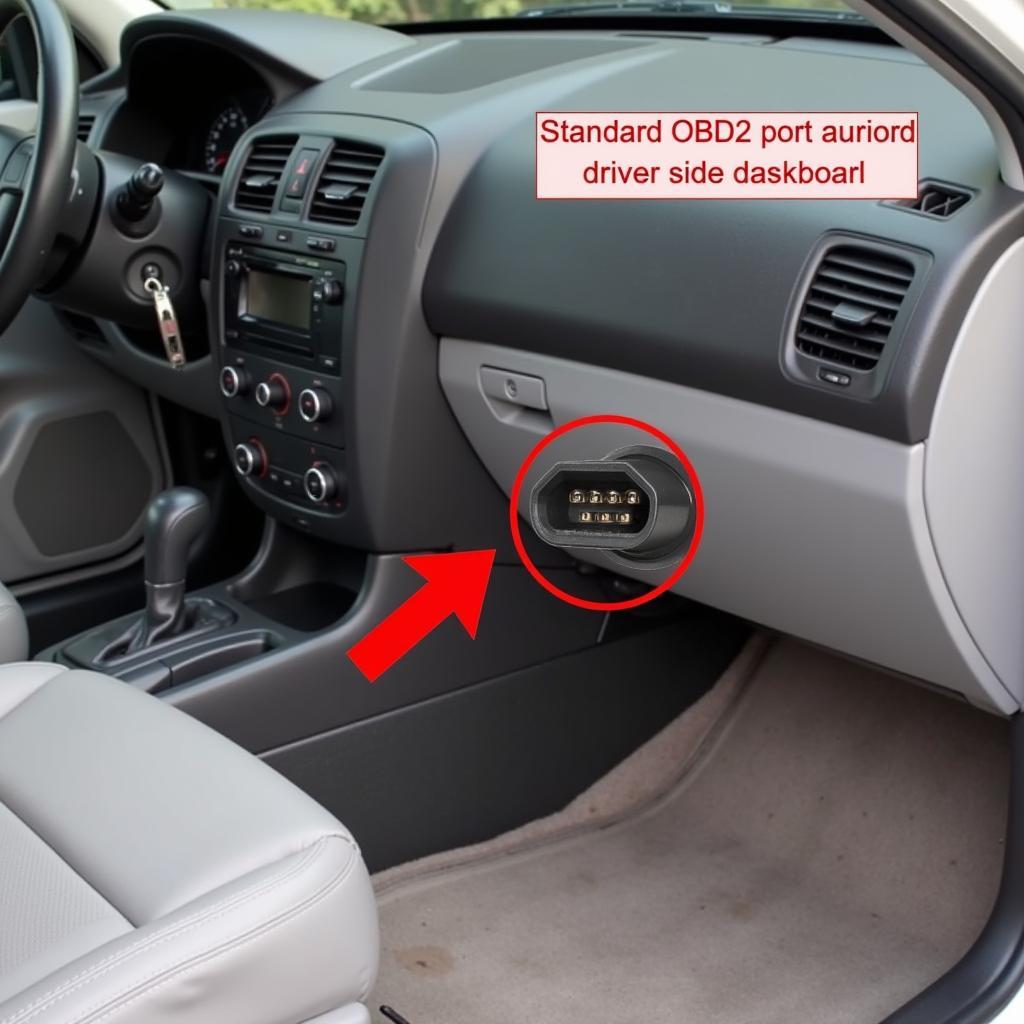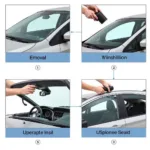The OBD2 port, short for On-Board Diagnostics II, is a crucial component of modern vehicles. It’s the gateway to understanding your car’s health and performance, providing valuable insights into potential issues and allowing for efficient diagnostics. This article delves into everything you need to know about the car diagnostic obd2 port, from its function to its potential uses. If you’re curious about accessing your car’s data, diagnosing problems, or simply monitoring performance, understanding this small port can be incredibly empowering.
The OBD2 port, typically located under the dashboard on the driver’s side, is a standardized interface that allows external devices to communicate with your car’s computer. It acts as a central hub for various sensors and systems within the vehicle, constantly collecting data on everything from engine performance to emissions. Accessing this data through the car diagnostic obd2 port can be invaluable for both car owners and professionals. You can find out more about helpful diagnostic tools on our page about the best android app for car diagnostic.
What Does the OBD2 Port Do?
The primary function of the OBD2 port is to facilitate diagnostics and troubleshooting. When a problem arises within your vehicle, the onboard computer stores a diagnostic trouble code (DTC) related to the malfunction. By connecting a diagnostic tool to the car diagnostic obd2 port, you can retrieve these codes and pinpoint the source of the issue. This saves time and money compared to traditional trial-and-error diagnostic methods.
Beyond Diagnostics: Other Uses of the OBD2 Port
While diagnostics are the core function, the OBD2 port’s capabilities extend beyond just reading trouble codes. It allows you to monitor various performance parameters in real-time, such as engine speed, coolant temperature, and fuel consumption. This information can be incredibly useful for tracking vehicle health, identifying potential problems before they become major issues, and even optimizing fuel efficiency. Some devices connected to the car diagnostic obd2 port can even offer advanced features like tracking vehicle location and providing driving behavior analysis. Are you interested in exploring some top-rated diagnostic machines? Check out our article on the top 10 car diagnostic machine.
How to Use the OBD2 Port
Using the car diagnostic obd2 port is relatively straightforward. You’ll need an OBD2 scanner or code reader, which can be purchased online or at most auto parts stores. Simply plug the scanner into the port, turn on the ignition, and follow the instructions provided with your specific device. Many modern scanners connect wirelessly to smartphones or tablets, providing a user-friendly interface for viewing and interpreting data. If you are in South Africa and looking for DIY tools, take a look at our recommendations for the best obd diagnostic tools car diy south africa.
Understanding OBD2 Trouble Codes
OBD2 trouble codes consist of a five-digit alphanumeric sequence. The first character indicates the system related to the fault (e.g., “P” for powertrain, “B” for body, “C” for chassis, “U” for network). The remaining digits provide more specific information about the nature of the problem. Understanding these codes can empower you to address minor issues yourself or provide valuable information to your mechanic.
What if I Can’t Find My OBD2 Port?
While the OBD2 port is usually located under the dashboard on the driver’s side, its exact location can vary slightly between vehicle makes and models. Consult your owner’s manual or search online using your car’s year, make, and model to find the precise location.
Choosing the Right OBD2 Scanner
There is a wide range of OBD2 scanners available, from basic code readers to advanced professional tools. Consider your needs and budget when choosing a scanner. Basic code readers are sufficient for retrieving and clearing trouble codes, while more advanced scanners offer real-time data monitoring, graphing capabilities, and other advanced features. If you’re looking for a cost-effective option, check out our article on second handwifi obd2 car diagnostic cable.
Keeping Your Car Healthy with the OBD2 Port
The car diagnostic obd2 port provides a powerful tool for monitoring and maintaining your vehicle’s health. By understanding its capabilities and using it effectively, you can take a proactive approach to car maintenance, saving time and money in the long run.
Expert Insight: “Regularly checking your car’s data through the OBD2 port can help you identify potential issues before they become major problems,” says John Miller, Senior Automotive Technician at Miller’s Auto Repair. “It’s like taking your car’s pulse.”
“The OBD2 port is an invaluable tool for any car owner,” adds Sarah Johnson, Lead Diagnostic Specialist at Johnson Automotive. “It allows you to stay informed about your car’s health and make informed decisions about maintenance and repairs.”
In conclusion, the car diagnostic obd2 port is a vital component of modern vehicles, providing a window into your car’s internal workings. Whether you’re a DIY enthusiast or simply want to stay on top of your car’s maintenance, understanding and utilizing this powerful tool can be incredibly beneficial. Looking for a free diagnostic test? You might want to look for options on our page, free car diagnostic test near me.
FAQ
-
What is the OBD2 port used for? Primarily for diagnostics, retrieving trouble codes, and monitoring vehicle performance.
-
Where can I find the OBD2 port in my car? Usually under the dashboard on the driver’s side. Check your owner’s manual for the exact location.
-
What kind of tools do I need to use the OBD2 port? An OBD2 scanner or code reader.
-
Can I clear trouble codes myself? Yes, most OBD2 scanners allow you to clear codes.
-
What do the OBD2 trouble codes mean? They indicate specific malfunctions within your vehicle’s systems.
-
Is using the OBD2 port difficult? No, most scanners are user-friendly and easy to operate.
-
Can the OBD2 port be used for anything other than diagnostics? Yes, it can be used to monitor vehicle performance, track location, and analyze driving behavior.
Need assistance with your car diagnostics? Contact us via WhatsApp: +1(641)206-8880 or Email: [email protected]. Our customer service team is available 24/7.



